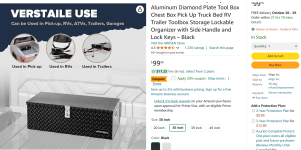My assumption was you’d be mounting them on the exterior of a trailer where they’d be exposed to cold temperatures. If you put them inside the heated cabin area then self heating would not be a requirement.
The Renogy batteries use 50wh to power the heaters but if there is no incoming charge they do not heat. That’s why each night they drop in temperature since there’s obviously no solar input. An insulated box would help but without a source of heat at night the temperature would still drop before morning unless you built something extremely bulky. At that point it would be easier to just modify the trailer wiring a bit and place the batteries inside.
The charge cutoff is also not at 0°F but 0°C (32F) for lithium. Might just be a typo since you said both F and C but want to make sure. Discharge is fine at temps well below 0°F though.
Ahh yah, typo, 0C

Renogy batteries, that explains it... what a poor design choice they made there. Well, it's a poor design for what we are discussing, and absolutely the wrong battery heat design. But there are other ones.
Most self heated battery I have looked at don't require input to heat, and will use up their charge as required to maintain the set temp. All the Redodo work that way, and the LiTime I've looked at. Here is the Redodo self heating, they are ACTUALLY self-heating, not "charger input heating":
Redodo 12V 100Ah LiFePO4 battery heater is equipped with 100W dual heating pads. This self-heating function automatically activates when the temperature of battery drops below 41°F (5°C). Once the temperature hits 50°F (10°C), heating stops, and the charing to the battery resumes normally. This revolutionary technology ensures effortless charging in cold environments.
Yah the basic requirements everyone I know with a truck camper uses are: LFP inside, in a well insulated box, stays heated overnight above 0C. A lot of folks use a reptile matt or floor heating pads to wrap battery, inside of an insulated case. They all still need to be self heated inside your camper, unless you're somehow heating camper constantly. Most folks I know actually have a self heated battery to ensure they can fire up a diesel heater after driving to camp in the cold.
It sounds like you are assuming a nice homey heated trailer setup, while I am thinking of overlanding and pickup truck camping, cold until you set up camp.
The insulation needed isn't that bulky for a single 100Ah LFP, which is all you need to bootstrap your system to start heating. Another option that I have used is a small 12V AGM that allows me to get diesel heater started, then I pipe the hot air around my LFPs as needed. Most LFP will discharge down to -20C or -4F, so you don't have to keep them that warm to draw on them to get a heater going. However, if you get below that and the BMS shuts off discharge, most folks I know report it doesn't turn back on until above 0C.
Just some more info for folks.

